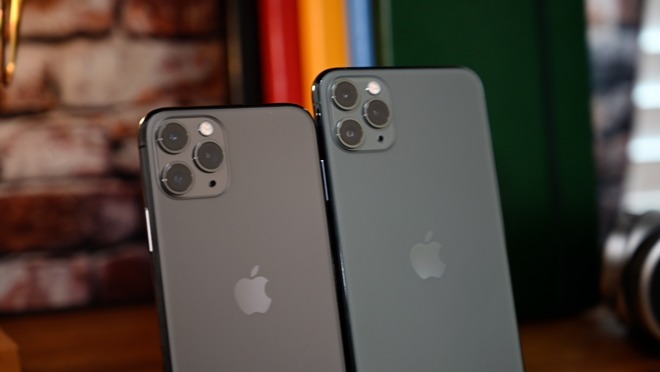While Apple managed to exceed Wall Street expectations to post an all-time quarterly earnings record for the first calendar quarter of 2020, a period heavily impacted by the COVID-19 pandemic, sales of its most important product, iPhone, slumped.
According to newly released estimates from Omdia and Strategy Analytics, iPhone sales contracted over quarter one as the wider smartphone market suffered the effects of the coronavirus outbreak.
Statistics compiled by Omdia's Smartphone Intelligence Service pegged iPhone shipments at 38.5 million units for the quarter, down 12% year-over-year and 45% sequentially. With an estimated 14% marketshare, the performance landed Apple in third place behind Samsung and Huawei.
Samsung shipped 58.9 million smartphones to take 21% of the market, down 17% from 71 million shipments and a 22% marketshare in the year ago quarter. Huawei maintained its 22% share of the market despite a 17.1% dip in quarterly shipments. The company shipped 49 million units in the first quarter.
Following Apple in fourth place was Xiaomi with 25.3 million units shipped and a 9% marketshare, down 8.2% year-over-year. Oppo, Vivo and Realme followed with 20.4 million, 19.5 million and 6.1 million shipments, respectively.
OMDIA's figures are slightly more conservative than estimates from Strategy Analytics, which put iPhone shipments at 39.2 million units and Apple's marketshare at 14.3% for the quarter. That number is down 9% from the research firm's estimates of 43.1 million shipments in the first quarter of 2019.
Samsung took the top spot with 58.2 million units shipped for a 21.2% slice of the pie, down 19% year-over-year, according to Strategy Analytics. Second place Huawei was down 18% with 48.5 million units shipped and a 17.6% share of the market.
Xiaomi and Oppo followed Apple with 27.5 million and 22.6 million smartphones shipped, respectively.
Overall, Omdia saw smartphone shipments contract 16.8% during the quarter, while Strategy Analytics estimates 17% negative growth over the same period.
Though Apple no longer breaks out unit sales in its quarterly reports, the company on Thursday noted a marked decline in iPhone revenue for its second fiscal quarter of 2020. Sales generated by the handset hit $28.96 billion in the quarter, down from $31 billion in 2019. Despite the drop-off, the company managed to eke out its best second fiscal quarter ever with $11.3 billion in profit on revenues of $58.3 billion. The Wall Street beat was largely thanks to Apple's services and wearables segments, both of which remarkably continued to grow during the difficult three-month period.
Update: IDC has also released estimates for the first quarter of 2020, finding Apple shipped 36.7 million iPhones to take 13.3% of the market, down 0.4% from last year. The smartphone industry as a whole contracted 11.7% year-over-year, with the biggest losses coming from the top-two vendors, Samsung and Huawei.
 Mikey Campbell
Mikey Campbell




-xl-m.jpg)


-m.jpg)






 Amber Neely
Amber Neely
 William Gallagher
William Gallagher
 Malcolm Owen
Malcolm Owen

 Mike Wuerthele
Mike Wuerthele


 Thomas Sibilly
Thomas Sibilly







6 Comments
Key comparison omitted:
Smartphone market as a whole down 17%. iPhone down only 12%.
OMG!
Apple is dead!
Oh, on the other hand...iPhone SE (version 2)
On the gripping hand...
Global tablet shipments are forecast to climb 45.5% sequentially and 9.9% on year in the second quarter of 2020 thanks to a recovery in the related supply chain's capacity in China and educational tablet orders deferred from the first quarter, according to Digitimes Research's latest tablet shipment figures.
Every single one of these figures are guesses, not actual facts. I’m sure iPhone sales were down a fair amount, but judging from the actual results it can’t logically be as much as Omdia (whoever the hell they are) and Strategy Guessers (check their track record) make out. I doubt the drop was as bad as the rest of the industry suffered. That’s the real story here.
Even if the numbers are actually representative, they remain due to exceptional circumstances and all the major vendors performed very well given the difficulties.
This first phase of COVID-19 relates how manufacturers reacted to its direct impact but now (assuming case numbers continue to improve) we will move into a second phase that is impossible to guess. The indirect impact. Many countries will enter technical recessions and many consumers will likely see their disposable income wiped out at least through to year end.
Luckily, I am buffered from the financial impact as I have a guaranteed (to a point) income but already I have had to inject cash into three branches of the family who had exhausted their bank credit lines. That means some important building work which already had to be postponed due to the outbreak, will now be postponed indefinitely. That means less work for local workers, who ironically, are the same people my family members sell to. It's a vicious circle. I fully expect that more family members will come asking for help and I know I'm not alone in the bigger scheme of things.
The upshot is that they will not be upgrading their phones until they are well out of the woods and if business doesn't start to pick up in eight weeks, they will begin to cut back on the unnecessaries like gyms, streaming services, horseriding, eating out etc.
The SE will shore up some sales for Apple especially in the U.S where demand isn't tempered by currency conversions and sales taxes but it is virtually impossible to know how things will play out. It is literally a case of analysing the situation week by week and seeking out ways to react as quickly as possible.
TSMC released its record breaking results not long ago and claimed demand for 5G related chipsets would keep things healthy but did warn of lower expectations in the CE space.